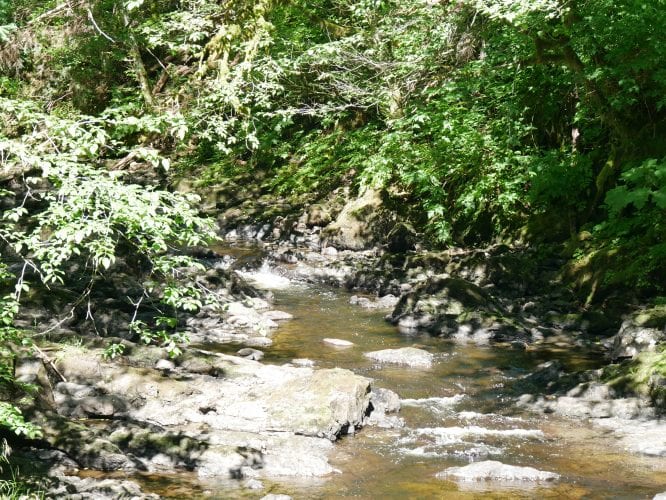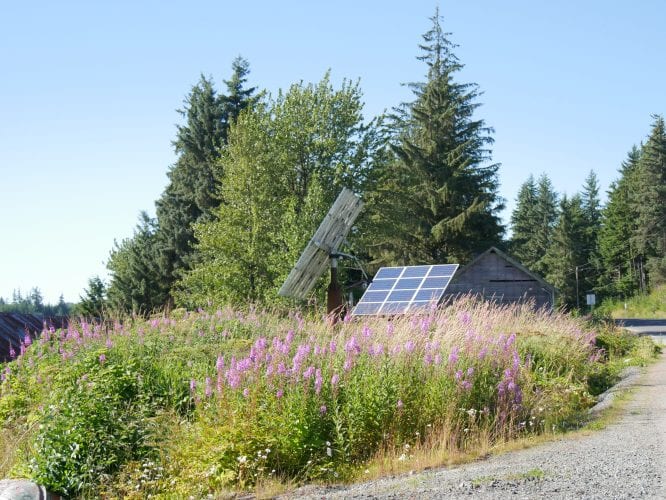Building is underway for a new hydropower facility in the Southeast Alaska community of Kake. Staff from the Inside Passage Electric Cooperative predict that the project will cover more than half of Kake’s power needs. Residential users likely won’t see lower power bills, and the benefits to schools and businesses will be spread across the utility’s 5 member communities.
Kake Tribal Fuel Company is a small corner store and gas station owned by the village corporation. Just a few yards away is a second store with the same owners called Kupreanof Mini. Keeping the two in lights and refrigeration isn’t cheap, according to Kake Tribal Board Member Delbert Kadake.
“I think we spend around 800 bucks over at our fuel station and about 1 thousand bucks since we opened up our mini mart, so under 2 thousand for running both of them,” Kadake said.
Those numbers may come down with the construction of a new hydropower plant at the old hatchery near town. Jodi Mitchell is CEO of Inside Passage Electric Cooperative, or IPEC, which provides electricity in Kake. Right now, all of the power IPEC generates in Kake comes from burning diesel. So, Mitchell said, it is hard to say exactly how much the project will save without knowing how future fuel costs. But, she gets asked this question a lot.
“So I went back 8 years, and discovered that if the project had been online over the past 8 years the project would have saved our members $2.7 million,” Mitchell said.
That breaks down to about $3.5 per kilowatt hour, but does not mean every person who gets power from IPEC would save that much. Since residential customers in Kake already get a state subsidy to make their electricity affordable, they won’t see much change at all.
“The savings for the residential customers stays with the Power Cost Equalization program,” Mitchell said. “So the state will be paying less into the subsidy. However the businesses, the schools, the churches, any business that does not receive Power Cost Equalization will see a rate reduction.”
Kadake’s position on the project is basically why not? Maybe it will spur economic development in Kake. Maybe lower costs will make it possible to reopen the local cold storage facility. Maybe it will help the corporation build a local tourism economy, which is its new focus for bringing jobs to Kake. Kadake said he would like to provide more food and lodging options to visitors.
“The people that do spend money are the independent travelers, the people that fly in and use the ferry. They’re the ones that spend time in your communities and they’re the people that we want to target,” Kadake said.
Still, he is skeptical that hydropower will help people. That is because Kake isn’t the first of the five communities IPEC serves to get a project like this in recent years. Hydropower came online in Hoonah in 2015, providing about a third of that community’s power. The utility has other plans in the cue, including a second project in Hoonah and one in Angoon. Electric rates for IPEC members are the same in Hoonah, Kake, Chilkat Valley, Angoon, and Klukwan, so the benefits of these projects spread across all of these users.
“Up in Hoonah it’s supposed to be helping out big businesses there but it hasn’t had the trickle-down effect and it’s not gonna help out our regular citizens of Kake. But for 10 million dollars you oughta be doing something. That’s a lot of money,” Kadake said.
Building the Hoonah project cost $10 million dollars and was grant-funded. Kake’s costs about 7 million, paid for by a combination of state and federal money. So this construction won’t create debt to be paid back with higher rates for consumers.
Fortunately for IPEC, there was already a dam near the hatchery in Kake, originally built to provide drinking water. It has not been used for years, and never for power, but Mitchell said, “there’s an outlet, and an intake. Everything is here to convert it to a hydroproject. So whoever engineered that dam was really brilliant and I’d sure like to thank them.”
Possibly the surest result of getting hydropower in Kake is that it will be a cleaner than burning diesel alone. Mitchell did some calculations over the phone.
“It looks like over 2 million pounds of CO2 in savings per year,” she said.
Of course, there are other options for renewable energy besides hydropower. In Kake, there are at least two sets of solar panels. One belonged to a private citizen, the other to the Organized Village of Kake. Mitchell said it is not economical for the small utility to build solar or wind projects, nor will they do incentives like net-metering, where they take off from a user’s electric bill the extra electricity they produce with their own solar panels.
IPEC will be one step further on its slog toward cheaper, cleaner power when the Kake project opens. Right now, contractors are mostly moving dirt around to prepare space for the penstock, the giant pipe that will lead from the existing dam to the hatchery. They will build a powerhouse at the hatchery next summer. Mitchell expects construction to finish in October 2019, though she said it could take longer.











